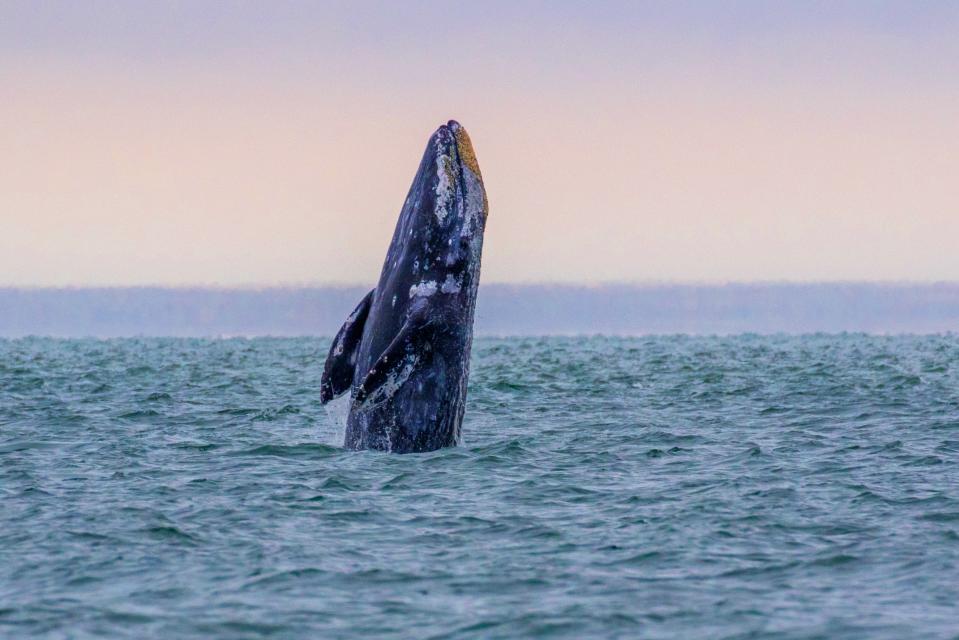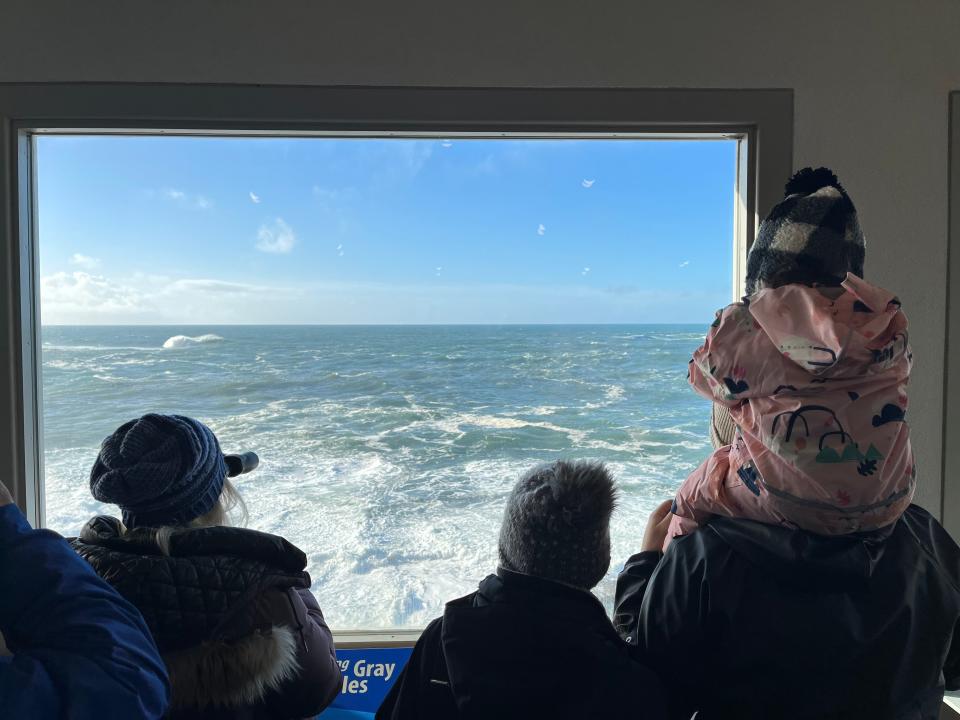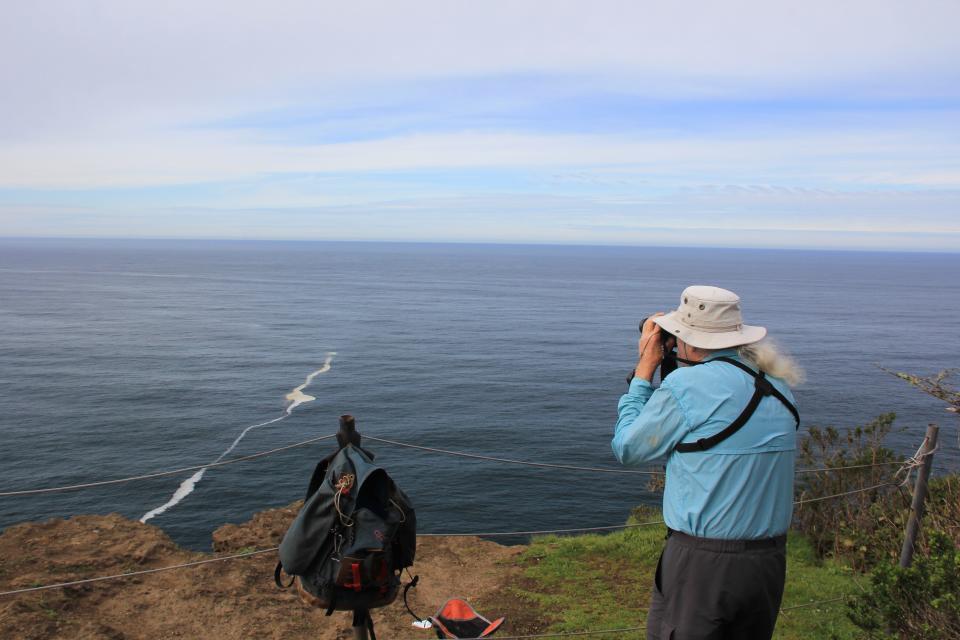Oregon’s spring Whale Watching Week returns, offers closer views of migration
Spring Whale Watching Week on the Oregon Coast offers one of the best chances to not only see one of nature’s most majestic animals, but to see them a bit closer.
Gray whales make two annual migrations — one southbound to the Baja in winter and another northbound to Alaska in spring.
Not only is the weather nicer in the spring, but the whales also tend to be easier to see, Oregon Parks and Recreation Department ranger Peter McBride said.
Explore Oregon Podcast: How to see Oregon's whales so close 'you can hear them breathe;' science of great grey whale migrations
“The gray whales are usually closer to shore on their return trip, typically around a mile or so out, and the weather is a little warmer for visitors,” McBride said.
This year, spring Whale Watching Week is March 28 to April 2. For those six days, trained volunteers will be stationed at 17 of the best whale watching sites to help visitors spot whales, share information and answer questions from 10 a.m. to 1 p.m. daily.

Decline in gray whale numbers
There should be a measure of joy in seeing whales swimming this season, especially following a spate of dead whales that washed up on Oregon Coast beaches this winter.
Four whales washed ashore in January — including two at Fort Stevens State Park. Lots of Oregonians traveled to the coast to see (and smell) the beached whales.
While it isn’t unusual for whales to wash ashore on the Oregon Coast, and indeed an average of six whales wash ashore each year, it did come in the midst of a decline in gray whale numbers overall. The gray whale population is estimated at 16,650, down 38% since 2016.

"NOAA Fisheries in 2019 declared an Unusual Mortality Event for gray whales that migrate along the West Coast because of a sharp increase in strandings followed by a decline in the population," NOAA Fisheries spokesman Michael Milstein said. "The population produced the fewest surviving calves on record last year since counts began in 1994."
Where are good spots to see the whales?
The best spot overall to see whales — and to do so from a warm indoor spot or an outdoor viewpoint — is the Whale Watching Center in Depoe Bay, which is open 10 a.m. to 4 p.m. Wednesday through Sunday.
“Visitors to the center can enjoy interactive whale exhibits and take in the panoramic ocean views. Binoculars are provided. Rangers from Oregon State Parks will also be on hand to answer questions about the whales,” a news release said.
The best time to see whales is the morning, when the ocean is backlit, but those traveling out should be sure to bring warm clothes.
Staffed whale watching sites
Fort Stevens State Park - Peter Iredale Shipwreck
Neahkahnie Mountain Overlook
Cape Meares Lighthouse
Boiler Bay State Scenic Viewpoint
The Whale Watching Center
Rocky Creek State Scenic Viewpoint
Cape Foulweather
Yaquina Head Outstanding Natural Area
Yaquina Bay Lighthouse
Yachats State Recreation Area
Cape Perpetua Turnout
Heceta Head Lighthouse
Umpqua Lighthouse
Shore Acres State Park
Face Rock Scenic Viewpoint
Ophir Wayside
Harris Beach State Park
Unique place to see whales — or mom-and-babies

In the past one of the sites staffed was the tip of Cape Lookout State Park. Even though it’s not this year, it remains one of the best places to spot a whale, being 2 miles out into the ocean.
It’s also a place where you have some of the best chances to see a truly magic sight — a mother and calf whale swimming north, just below the cape.
Gray whale mothers will often keep her calves — born just a month or so earlier in the warm Baja waters — close to shore, passing remarkably close to places such as Cape Lookout, to avoid the detection of orcas (killer whales), which hunt calves during the northbound migrations.
“Orcas hunt the newborn calves, but because they use echolocation, they like to be out in deeper water,” Oregon Parks and Recreation Department whale expert Luke Parsons said on the Explore Oregon Podcast. “Because of that, gray whale moms will bring their calves super close to shore because the rocks and waves make it too turbulent for orcas to hunt very well.
“Cape Lookout can be a really cool spot in the northbound migrations because it sticks out so far it can kind of capture those mother and babies swimming back up north, and it’s pretty unreal how close they’ll come to shore.”
Naturally, those types of sightings are rare, but they do happen and it’s one of the reasons whale watching week remains so popular in spring.
To reach the tip of Cape Lookout, follow the Cape Trail 5 miles round-trip on a spectacular and moderately difficult hike.
For more information, got to bit.ly/3TBmzvg
Zach Urness has been an outdoors reporter in Oregon for 15 years and is host of the Explore Oregon Podcast. Urness is the author of “Best Hikes with Kids: Oregon” and “Hiking Southern Oregon.” He can be reached at zurness@StatesmanJournal.com or 503-399-6801. Find him on Twitter at @ZachsORoutdoors.
This article originally appeared on Salem Statesman Journal: Oregon’s spring Whale Watching Week returns, offers closer views

